
This is an extract from our August CLEAN Lessons Learned session “Getting Serious About Airborne Infection Transmission” where Dr. Lidia Morawska gave a presentation about the airborne nature of the COVID-19 virus and others.
At our CLEAN Lessons Learned Session: “Getting Serious About Airborne Infection Transmission,” we discussed the reasons why it took so long for the US and other parts of the world to accept that COVD-19 is an airborne virus.
Continue reading for a breakdown of the actions that led to this situation and a summary of the problem.
Semantics Can Be Confusing
Is it aerosol or droplet?
In the world of physicists, the definition of an aerosol is an assemblage of liquid or solid particles suspended in a gaseous medium long enough to enable observation or measurement.
On the other hand, a droplet is a liquid particle. So its composition has nothing to do with size.
However, due to the pandemic, a problem arose regarding other medical sciences. Aerosol is defined as a small particle, and droplets are defined as a large particle with a division of around five micrometers.
“My attitude to this is to even the definitions eventually, and stop trying to convince each other what the terminology should be.”
Dr. Lidia Morawska.
There is a great chance that these semantic discrepancies caused confusion at the beginning of the pandemic.
What is Airborne Transmission?
Let’s start with the beginning. What is an airborne transmission?
The keyword to this is “inhalation.” Specifically, inhalation of virus-laden particles anywhere in the space.
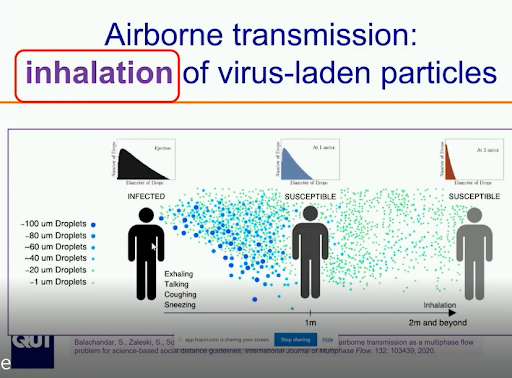
As you can see in the image above, we initially got that cloud of absolutely everything, particles of all sizes, high concentrations. Then gradually, the situation settles, and we have lots of smaller particles.
To exemplify, you can compare this situation to the emissions of a car in an urban setting. You would also see a cloud of everything mixing, but then eventually, you’ve got just this urban background at a distance.
So initially, ideas were suggesting airborne transmission is what happens past that defined close range. Still, airborne transmission is the inhalation of any particles anywhere in the space, whether at a distance beyond 1 m, 2 m, or less.
The Problem With Those First WHO Statements
At the beginning of the pandemic, in March 2020, WHO tweeted statements stating that COVID-19 wasn’t airborne. However, we knew that it was airborne like any other respiratory virus.

There were also statements plaguing the web and media about masks not being able to stop the spread.

After this, Dr. Lidia Morawska and others strived to create as many investigations as possible to bring attention to the fact that the COVID-19 virus is airborne.
When The Change Started
WHO started to slowly change their statement. However, the big change occurred in July of 2021.
The paper “It is Time to Address Airborne Transmission of COVID-19” was published with the collaboration of 239 scientists from 34 countries, including Lidia Morawska. It is not called “The Open Letter.”
The following day after the paper was published, WHO acknowledged “evidence emerging” of the airborne spread of the coronavirus.
Over the months following this acknowledgment, much more happened; for example, there was a change of focus on ventilation. Specifically, there was a statement by Maria Nera, a great leader within WHO and leads the work on ventilation.
There was acknowledgment to the fact that ventilation is needed to provide a preventive viral spread,
In March 2021, the roadmap to improve and ensure good indoor ventilation in the context of COVID-19 was announced.
This is a great document; however, it doesn’t address the airborne nature of the virus; this aspect is missing from there. It still needs to come in the most recent brief on this topic.
In May 2021, WHO said that infectious exposure to the respiratory fluids carrying SARS-CoV-2 occurs in three principal ways (not mutually exclusive).
One of them is the inhalation of air carrying very small fine droplets and aerosol particles that contain the infectious virus.
This was a crucial step forward.
What About Other Parts Of The World – Acceptance VS Action
Unfortunately, there is still a disconnect between acceptance, action, and talking about ventilation.
In Italy, the Instituto Superiore di Sanitá fully recognized airborne transmission several months ago and the need for control measures. However, according to Italian scientists, the actual actions to improve ventilation are still lagging.
A very different situation occurred in Germany. The German government started last year improving ventilation, offering grants to improve ventilation in public venues, offices, museum theaters, etc.
Acceptance of COVID-19 being airborne has significantly and generally increased. It is accepted now.
But there is still little action in most countries to control it utilizing ventilation.
What would you do to increase the actions needed in your country?
2 Comments
Leave a Comment
Related Blogposts
Interdisciplinary Collaboration in Environmental Science: Pioneering Health Solutions with IBEC’s New CSO
The Integrated Bioscience and Built Environment Consortium (IBEC) proudly introduces its new Chief Scientific Officer (CSO), Stephane Bilodeau. Bringing over 25 years of diverse experience…
Navigating the Rise of Bacterial Pneumonia: Insights and Precautions
Navigating the Rise of Bacterial Pneumonia: Insights and Precautions As winter’s chill sets in, health professionals and organizations brace for the annual uptick in respiratory…
New COVID-19 Variant JN.1 Raises in the United States
JN.1 is a highly contagious, fast-spreading subvariant of omicron that has become the dominant strain in the country. According to data from the Centers for…
Pioneering Steps to Control Infectious Aerosols: Dr. Claire Bird Offers Expert Insight on ASHRAE’s New Draft Standard
As we navigate through the challenges posed by the COVID-19 pandemic and other airborne diseases, there is a dire need to implement measures that will…
IBEC Takes the Lead in Developing a Framework for Reducing Indoor Pathogen Transmission
Dear IBEC Partners and Supporters, As we continue to navigate the ongoing threat of airborne pathogens transmission in our shared indoor communities, it’s more important…
New Commit To C.A.R.E. Resources Deliver Innovative Indoor Air Quality Solutions for Safer Workplaces
The Commit to C.A.R.E initiative The Integrated Bioscience and Built Environment Consortium (IBEC) and The American Industrial Hygiene Association (AIHA), two leading organizations committed to…
Staying Ahead of Severe GAS Infections and Other Secondary Bacterial Infections
Severe Group A Streptococcal (GAS) infections, including invasive disease (iGAS), can lead to life-threatening illness and death. CDC is looking into an increase in…
Industry Leader L’Oréal Pledges to Support Commit to C.A.R.E.
Industry Leader L’Oréal Pledges to Support Commit to C.A.R.E. With health experts warning of the triple threat of the continued spread of new COVID-19…
C.L.E.A.N. Lessons Learned: How to protect the healthcare system from current and future pandemics
The COVID-19 pandemic caught the world off guard. Health organizations all over the globe rushed into a quick response to protect people from the threat…
The CEAT: a powerful tool for infectious disease risk assessment
The CEAT is a powerful tool for infectious disease risk assessment. Keep reading to learn about its development and use. We will never forget March…
Interdisciplinary Collaboration in Environmental Science: Pioneering Health Solutions with IBEC’s New CSO
The Integrated Bioscience and Built Environment Consortium (IBEC) proudly introduces its new Chief Scientific Officer (CSO), Stephane…
Navigating the Rise of Bacterial Pneumonia: Insights and Precautions
Navigating the Rise of Bacterial Pneumonia: Insights and Precautions As winter’s chill sets in, health professionals and…
New COVID-19 Variant JN.1 Raises in the United States
JN.1 is a highly contagious, fast-spreading subvariant of omicron that has become the dominant strain in the…


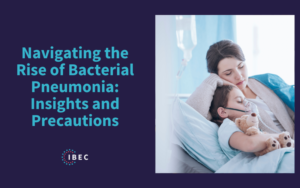
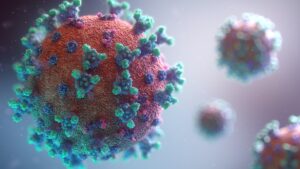







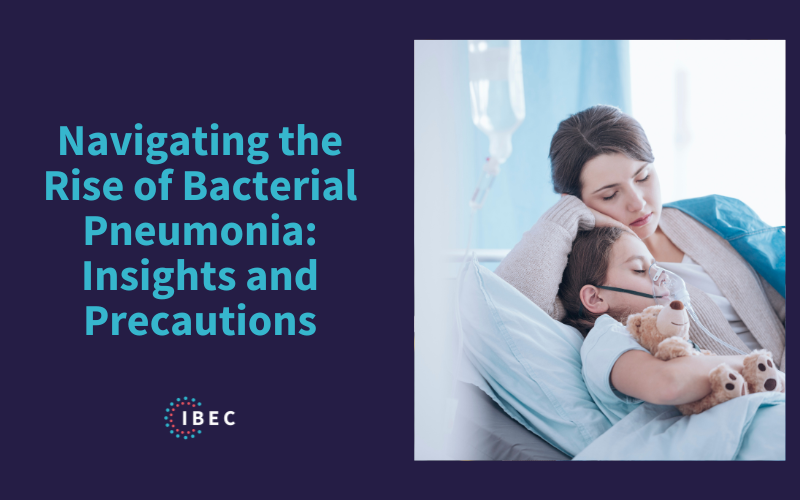
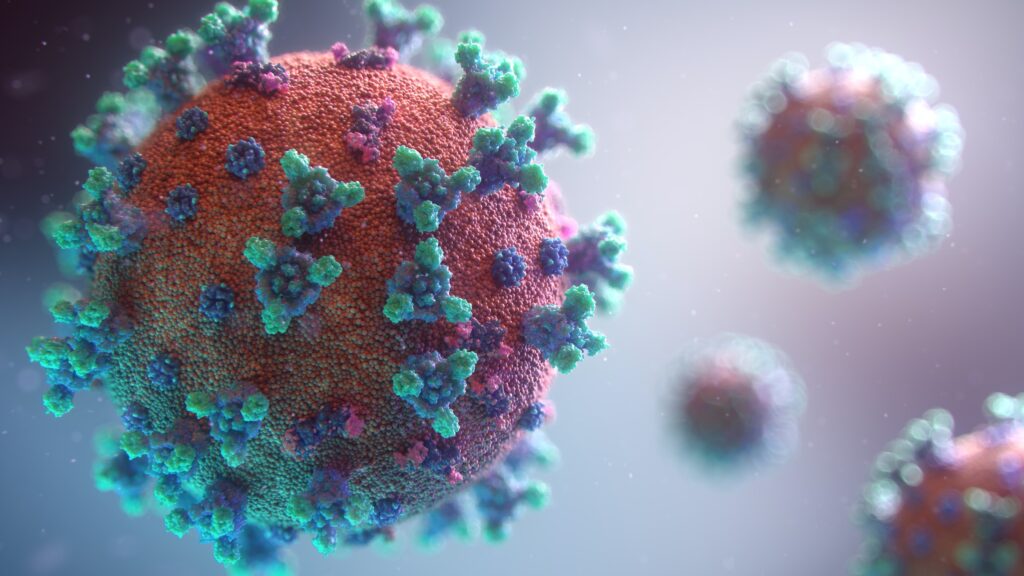
[…] By The Pandemic. COVID 19, Crisis Response, Mental Fatigue & Resilience. Beyond COVID-19. Why Did It Take So Long To Accept COVID Is Airborne? Top Guidelines To Follow In The COVID-19 […]
[…] mask mandates, has led to widespread uncertainty. Keep reading for more recommendations to reduce airborne disease transmission in public transport using the NIOSH Hierarchy of […]